Dorylus (Rhogmus) fimbriatus
(Shuckard)
 Male Male 
 Type location Gambia
(Rhogmus fimbriatus, Shuck., Shuckard, 1840c: 325, male, no
locality given; Emery, 1895j, 736, worker; Brauns, 1903: 294, queen) -
see below Type location Gambia
(Rhogmus fimbriatus, Shuck., Shuckard, 1840c: 325, male, no
locality given; Emery, 1895j, 736, worker; Brauns, 1903: 294, queen) -
see below
subspecies
crampeli (Dorylus
(Rhogmus) fimbriatus Shuck. var. Crampeli n. var., Santschi, 1919b:
232, male) from Congo - no images on Antweb (June 2014; a
search under crampeli leads
to the type male of laevipodex)
poweri (Dorylus
(Rhogmus) fimbriatus Shuck.
v. Poweri n. var., Forel,
1914d: 217, worker) from South Africa - see below
laevipodex (Dorylus
(Rhogmus) fimbriatus Shuck. var. laevipodex n. var.,
Santschi, 1919b: 232, male) type location Kenya - see http://www.antweb.org/specimenImages.do?code=casent0911347
all forms
known (see
Bolton, 1995)  . .
|
Shuckard's (1840c) description is at  . F Smith (1859b: 4) gave - . F Smith (1859b: 4) gave -  . Emery's (1895j) translation into German
of Shuckard's (1840c) description, with illustrations of the male, is
at . Emery's (1895j) translation into German
of Shuckard's (1840c) description, with illustrations of the male, is
at  . Emery (1901c: 187) had an illustrated
description of the worker morphs - . Emery (1901c: 187) had an illustrated
description of the worker morphs -  . Forel's (1914d) description of poweri
is at . Forel's (1914d) description of poweri
is at  . Arnold (1915) gave full
descriptions of all the life stages, with an illustration of the queen,
these are at . Arnold (1915) gave full
descriptions of all the life stages, with an illustration of the queen,
these are at  , ,  and and  . The male description is a transcription
of Shuckard's original description. Santschi's (1919c) description of crampeli
is at . The male description is a transcription
of Shuckard's original description. Santschi's (1919c) description of crampeli
is at  and laevipodex
at and laevipodex
at  . Boven (1967a: 55) made
a comparative study of the queens of fimbriatus (from Ivory
Coast) and the termitarius (holotype), with illustrations; this
is at . Boven (1967a: 55) made
a comparative study of the queens of fimbriatus (from Ivory
Coast) and the termitarius (holotype), with illustrations; this
is at  . .
* Note - The Antweb image collection has a male
labelled Dorylus laevipodex by W H Gotwald. Prior the availablity (June 2014) of the Santschi laevipodex type, which appears to match the fimbriatus type male in every detail, I agreed with Gotwald's separation. I still do but the specimen is not laevipodex - see Dorylus
(Rhogmus) ??.
Brauns, J. 1903. Ueber das Weibchen von Dorylus (Rhogmus) fimbriatus Shuck.
(Hym.). Zeitschrift für
Systematische Hymenopterologie und Dipterologie 3: 294-298, listed but not available
in HNS.
|
 Emery (1901c) gave
the sizes as: Major TL 7.5 mm; minima with 11-segmented antennae, TL
3.5 mm; 10-segmented antennae, TL 2.7-3.1 mm;
9-segmented antennae, TL 2.6-3.0 mm; 7-8-segmented antennae, TL 1.7-2.2
mm. The series of workers was sent to Emery by Dr J Brauns, who
lived in Willowmore, South Africa (Brauns, J., 1903). The
specimens came from a nest in "Maschunaland", near Salisbury, Rhodesia
(Harare, Zimbabwe) sampled by G.A.K. Marshall. Earlier, Emery (1895j)
wrote of the worker as hitherto being unknown but two small workers, TL
2-2.25 mm, were found with a male from Sierra Leone. So,
presumably, his recognition of workers as fimbriatus is tenuous, although
Brauns related sending Emery the males and workers.. Emery (1901c) gave
the sizes as: Major TL 7.5 mm; minima with 11-segmented antennae, TL
3.5 mm; 10-segmented antennae, TL 2.7-3.1 mm;
9-segmented antennae, TL 2.6-3.0 mm; 7-8-segmented antennae, TL 1.7-2.2
mm. The series of workers was sent to Emery by Dr J Brauns, who
lived in Willowmore, South Africa (Brauns, J., 1903). The
specimens came from a nest in "Maschunaland", near Salisbury, Rhodesia
(Harare, Zimbabwe) sampled by G.A.K. Marshall. Earlier, Emery (1895j)
wrote of the worker as hitherto being unknown but two small workers, TL
2-2.25 mm, were found with a male from Sierra Leone. So,
presumably, his recognition of workers as fimbriatus is tenuous, although
Brauns related sending Emery the males and workers..
Santschi (1930a: 56) reported workers from Soudan
Francaise (now Mali), Koulouba (Andrieu), 28 workers, that differed
little from fimbriatus (?)
but were no more than TL 5.5 mm, which led him to suppose they could be
the workers of the variety Crampeli
which had small males.
Arnold (1915) wrote of the largest workers as having
dense puncturation and a dull, finely but distinctly rugulose alitrunk.
On the head the sculpture was anteriorly finely punctured,
microscopically rugulose and dull, behind that the head was closely and
strongly punctured with the interspaces smooth and shining.
|
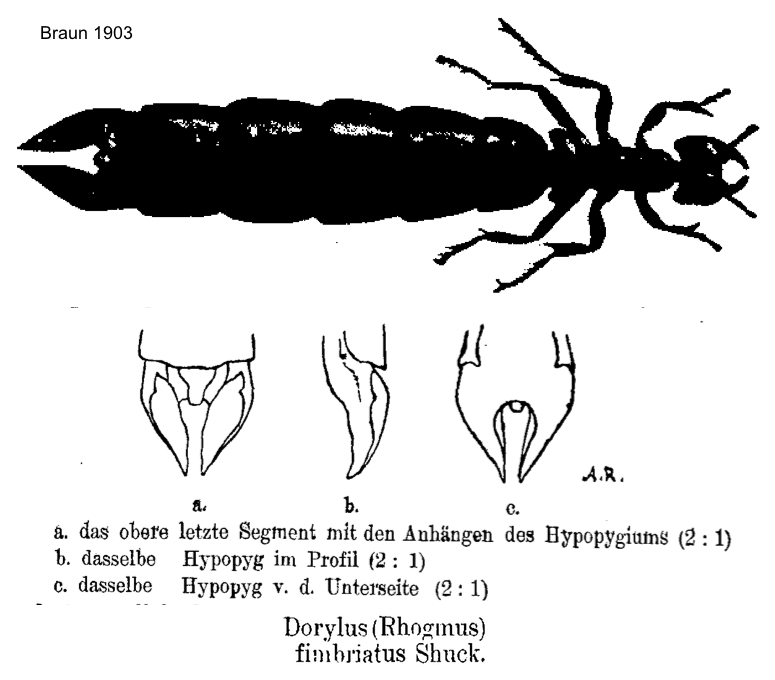 Queen illustrations
from Brauns (1903). The
specimen came from a nest in "Maschunaland", near Salisbury, Rhodesia
(Harare, Zimbabwe) sampled by G.A.K. Marshall. Queen illustrations
from Brauns (1903). The
specimen came from a nest in "Maschunaland", near Salisbury, Rhodesia
(Harare, Zimbabwe) sampled by G.A.K. Marshall.
|
Santschi (1930a: 56) reported workers from Soudan
Francaise (now Mali), Koulouba (Andrieu), 28 workers, that differed
little from fimbriatus (?)
but were no more than TL 5.5 mm, which led him to suppose they could be
the workers of the variety Crampeli
which had small males.
|
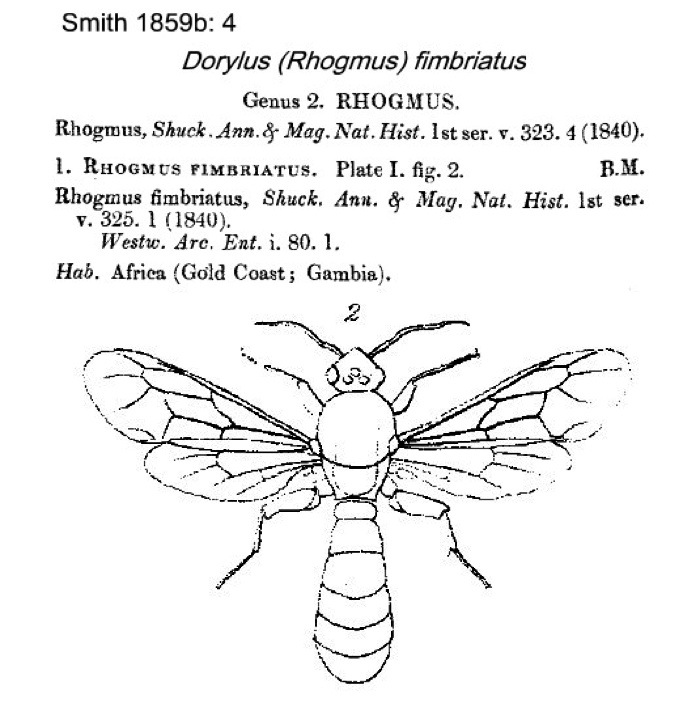 Santschi's (1919b)
brief description of crampeli
notes only that the male was somewhat smaller than the type, e.g. HW
4.4, and the pygidium with paler pubescence. He separated laevipodex
as slightly more robust; the gaster up to 7.3 mm long, the anterior
wing 23 mm; the outer third of the mandible is not concave; the
pygidium without pubescence and the hairs are long, fine and clear, so
that the segment seems entirely smooth and shiny. Santschi's (1919b)
brief description of crampeli
notes only that the male was somewhat smaller than the type, e.g. HW
4.4, and the pygidium with paler pubescence. He separated laevipodex
as slightly more robust; the gaster up to 7.3 mm long, the anterior
wing 23 mm; the outer third of the mandible is not concave; the
pygidium without pubescence and the hairs are long, fine and clear, so
that the segment seems entirely smooth and shiny.
|
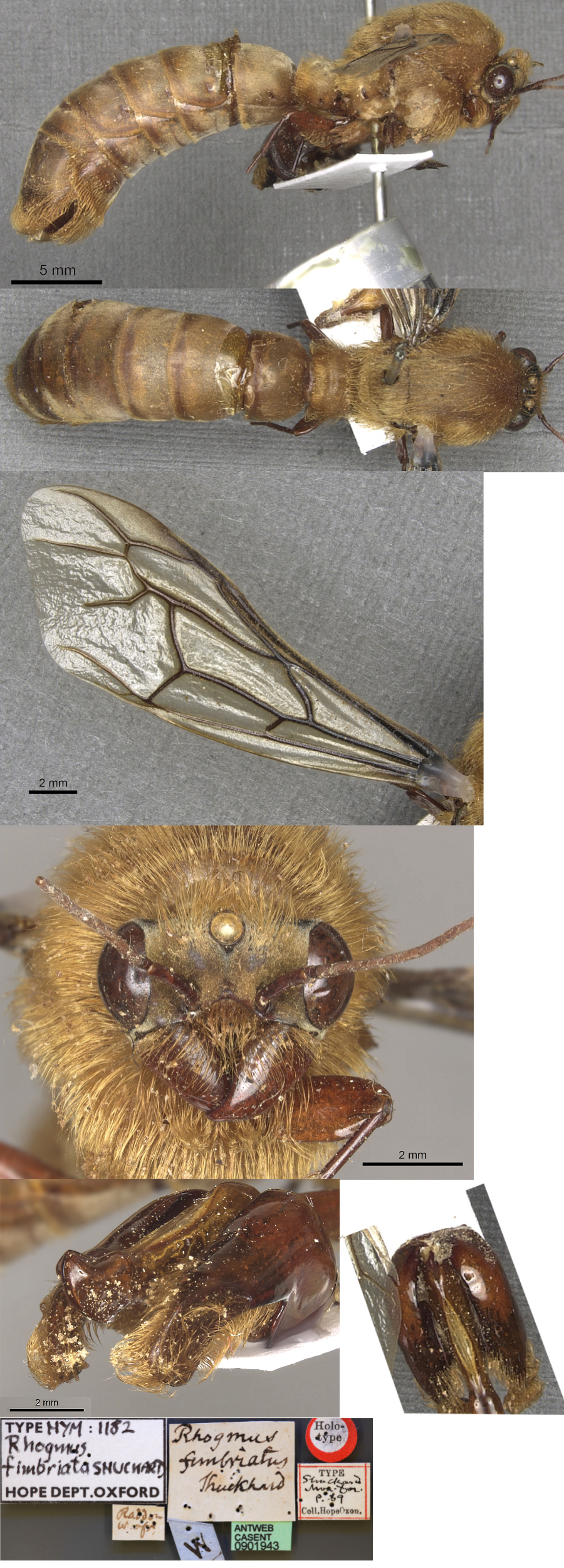 The
photomontage is of the holotype male collated from http://www.antweb.org/specimen.do?name=casent0901943. The
photomontage is of the holotype male collated from http://www.antweb.org/specimen.do?name=casent0901943.
|
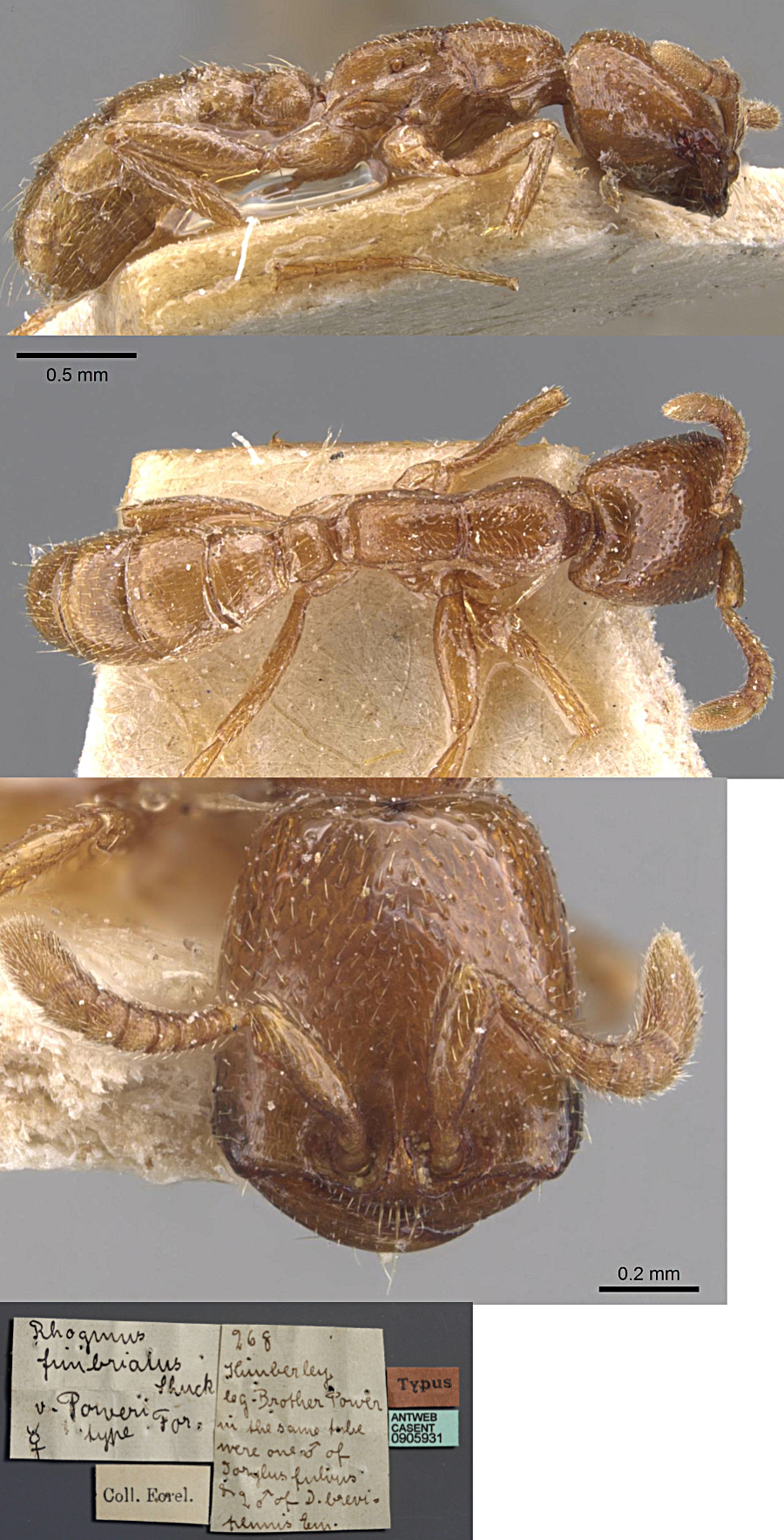 The
photomontage is of a type minor worker of poweri collated
from http://www.antweb.org/specimen.do?name=casent0905931.
This and the workers from Senegal (below) and Nigeria all appear to be similar. The
photomontage is of a type minor worker of poweri collated
from http://www.antweb.org/specimen.do?name=casent0905931.
This and the workers from Senegal (below) and Nigeria all appear to be similar.
Note: The Antweb
page for Dorylus fimbriatus poweri
also has images of a major worker with labels for this species. I show
a photomontage at the bottom of this page but the specimen
actually seems to be a major worker of D.
(D.) brevipennis.
|
 Nigeria
specimens (Taylor, 1980b: 19). WORKER. TL
7.16-2.12 mm . Five morphs; largest HL 1.56, HW 1.40, SL 0.56, PW 0.87 Nigeria
specimens (Taylor, 1980b: 19). WORKER. TL
7.16-2.12 mm . Five morphs; largest HL 1.56, HW 1.40, SL 0.56, PW 0.87
Colour dark orange-brown. Head, alitrunk and petiole finely
reticulostriate, striations more marked dorsally. Scattered hair-pits
on all dorsal surfaces, coarser on head. Erect hairs sparse but two
pairs on propodeum, a few on both surfaces of the petiole and gaster,
very long on first sternite. Relatively abundant pilosity on the dorsal
alitrunk, petiole and all over gaster. Mandibles with a moderate apical
tooth, the subapical tooth bluntly bifurcate and basal tooth reduced.
Anterior clypeal margin straight but projecting forward slightly.
Alitrunk dorsum flat. Subpetiolar process a small rear-curved triangle.
I collected it at the Cocoa Research Institute of Nigeria, Idi Ayunre.
from a tree stump and outside a ground nest, perhaps migrating.
Wheeler (1922) listed findings from Guinea at
Conakry and Mamou (F. Silvestri), Ghana, Cameroun and
many other tropical African countries.
Schneirla (1971) noted it as inhabiting the "deep
subterranean zone".
|
Oxford University Museum
specimens
Dorylus (Rhogmus) fimbriatus
B Taylor det.
|
Senegal
Tambacounda
B Ndiaye
|
10.viii.2009
Bansifoukha
13°06'30"N
12°05'18" W
|
Bansifoukha
10-VIII-09 St11 au sol
Soudanian savannah, hand collection, on ground
|
4
|
 |
|

The photomontage is of a media 1 worker from Senegal,
Dzanga-Sangha NP; collector B Ndiaye (CAR
NX).
|
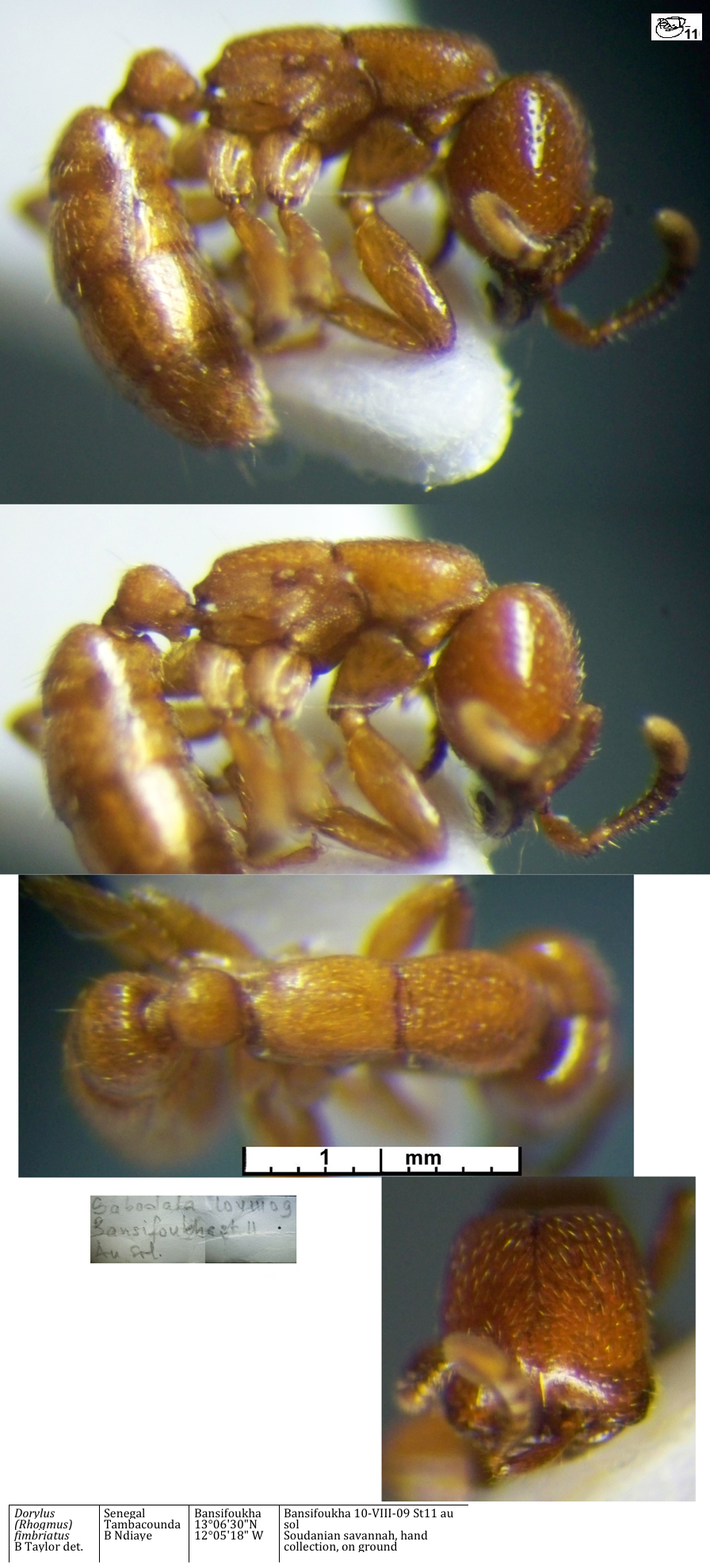 The photomontage is of a media
2 worker from Senegal,
Dzanga-Sangha NP; collector B Ndiaye (CAR
NX). The photomontage is of a media
2 worker from Senegal,
Dzanga-Sangha NP; collector B Ndiaye (CAR
NX).
|
 The photomontage is of a
minima worker from Senegal,
Dzanga-Sangha NP; collector B Ndiaye (CAR
NX). The photomontage is of a
minima worker from Senegal,
Dzanga-Sangha NP; collector B Ndiaye (CAR
NX).
|
 The
photomontage of what may be a minima from Gabon is collated from http://www.antweb.org/specimen.do?name=casent0235172&shot=p1&project=null.
There it is listed as Dorylus fulvus,
although the morphology and appearance matches the worker above, it is
much smaller (assuming the scales to be correct) but it certainly is
not a specimen of D. fulvus. The
photomontage of what may be a minima from Gabon is collated from http://www.antweb.org/specimen.do?name=casent0235172&shot=p1&project=null.
There it is listed as Dorylus fulvus,
although the morphology and appearance matches the worker above, it is
much smaller (assuming the scales to be correct) but it certainly is
not a specimen of D. fulvus.
|
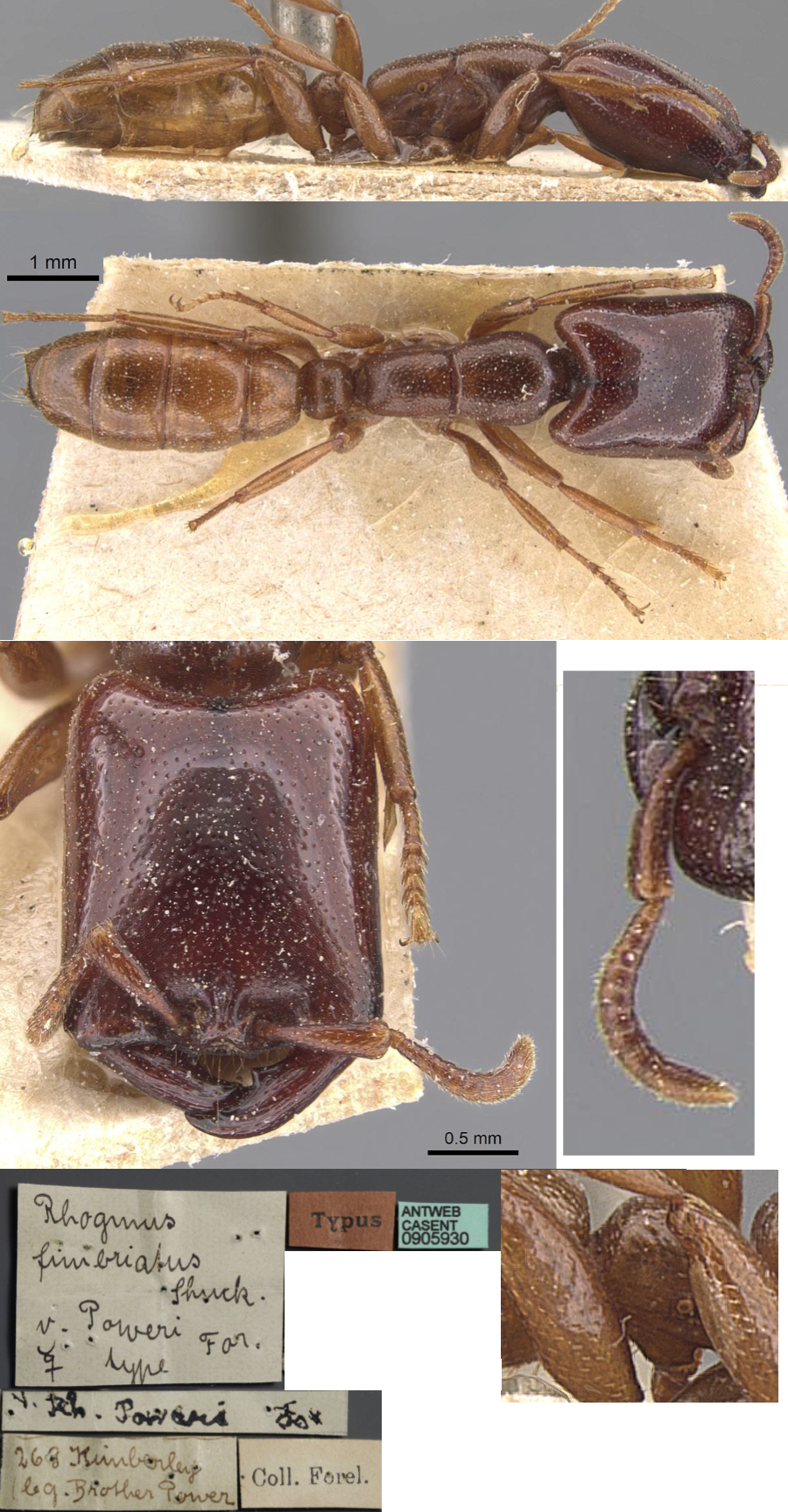 The
photomontage is of a major worker labelled as the type major worker of poweri
collated
from http://www.antweb.org/specimen.do?name=casent0905930. The
photomontage is of a major worker labelled as the type major worker of poweri
collated
from http://www.antweb.org/specimen.do?name=casent0905930.
Note This does not match the description and
appears, in fact, to be a major worker of Dorylus (D.) brevipennis.
|
|